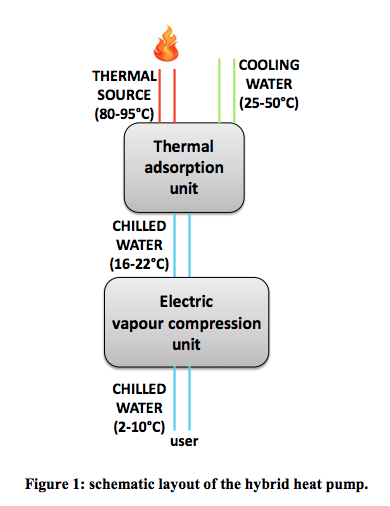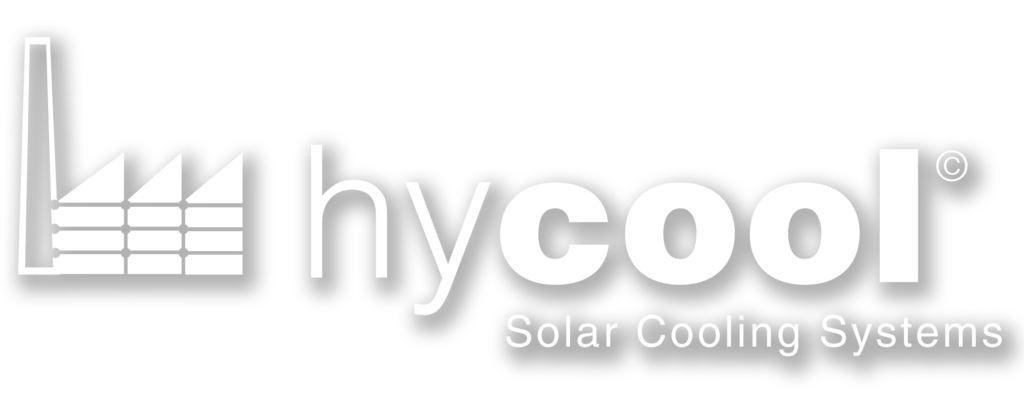By Valeria Palomba, Andrea Frazzica, Steffen Kühnert, André Große
Istituto di Tecnologie Avanzate per l’Energia CNR-ITAE, Messina (Italy)
Fahrenheit GmbH, Halle (Germany)
Last September our colleagues Valeria Palomba, Andrea Frazzica, Steffen Kühnert and André Große
presented the following paper on Hycool at the Eurosun conference held in Rapperswill:
ABSTRACT
This paper presents the dynamic modelling of a hybrid cascade chiller for solar cooling in industrial applications driven by Fresnel solar thermal collectors. The chiller comprises an adsorption module, which is directly connected to the bottoming vapor compression chiller. This cascade configuration allows enhancing the overall electric COP, since the adsorption module is operated to dissipate the heat rejected by the vapor compression chiller, thus reducing the condensation temperature quite below the ambient temperature. The model was implemented in Dymola/Modelica, allowing describing heat and mass transfer phenomena inside each component. The complete model was then validated against experimental data obtained on a cascade chiller prototype at the CNR ITAE lab. Finally, a reference daily simulation was performed to evaluate the ability of the developed chiller in providing cooling energy to a typical industrial application
Keywords: Dymola/Modelica, cascade chiller, industrial solar cooling
1. Introduction
The cooling demand is continuously growing worldwide in different sectors (Werner, 2016). Particularly, energy consumption and related emissions due to cooling processes in industrial sector are becoming a major issue. For this reason, the integration of renewable thermal energy sources inside industrial sites, for both heating and cooling applications is gaining a lot of attention (Farjana et al., 2018). Usually, it is accomplished with the use of thermally driven sorption machine, driven by thermal energy produced by non-concentrating solar thermal collectors (e.g. flat plate, evacuated tubes) (Murray et al., 2016). Nevertheless, this approach suffers of some weaknesses: first, when renewable source (i.e. solar energy) is not available, a backup system is needed to either operate the sorption chiller (e.g. gas boiler) or to directly produce cooling by means of standard technology (e.g. vapour compression chiller).
Secondly, the use of non-concentrating solar thermal collectors technologies often is not sufficient to properly drive the sorption machine, thus making it work under off-design conditions for several hours. Furthermore, these solar thermal collectors cannot be integrated as heating source in most of the industrial sites, since the achievable temperature level is usually not sufficient drive any process.
In such a background, the EU co-funded project HyCool (HyCool, 2018) aims at increasing the use of solar heat in industrial processes, integrating a concentrating Fresnel solar thermal collector technology, with a hybrid cascade chiller, to increase the share of renewable sources for heating and cooling applications in industries.
The present paper deals with the development of a numerical model, implemented in Dymola/Modelica, for the simulation of the innovative cascade chiller. The model describe heat and mass transfer phenomena in each component of the chiller, in order to accurately simulate its operation. Furthermore, it has been validated by means of experimental data measured at the CNR ITAE lab and it will be further used to evaluate optimal operating conditions and management strategies under typical working boundaries of an industrial plant.
2. The Hybrid cascade chiller
The hybrid heat pump is made up of two units, working in cascade mode: a thermal unit and an electric unit. The thermal unit is an adsorption chiller, based on the system already commercialised by Fahrenheit, which will be driven by the heat produced by a field of Fresnel solar thermal collectors, for the production of chilled water in the range of 16-22°C. This unit is hydraulically connected to the condenser of an electric vapour compression unit (i.e. cascading mode), which will provide chilled water to the user. In such a way, the adsorption unit is primarily meant for dissipating the condensation heat of the vapour compression unit. This operation allows increasing the overall electric COP, by reducing the temperature lift between evaporator and condenser of the vapour compression unit, thus limiting the compressor work.
Furthermore, the utilization of the cascading operation of the two units allows exploiting the benefits of the two types of systems, i.e. the low primary energy consumption of the thermal unit, which will be fed by renewable solar energy, and the fast response and good temperature control under different conditions of the electric unit (Vasta et al., 2018). A schematic of the hybrid heat pump operation and components as well as the different temperature levels is reported in Figure 1.
3. Dynamic modeling and validation
As shown in Figure 1, the hybrid heat pump is realized by hydraulically connecting the thermal and electric units. Consequently, the models for the two units were implemented and tested separately and then the overall model for the system was assembled and calibrated. […]


